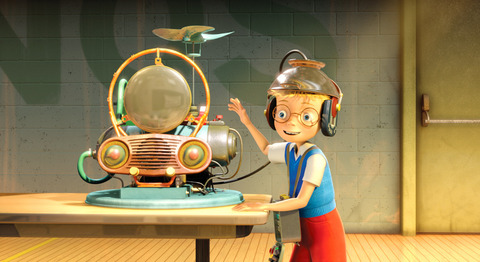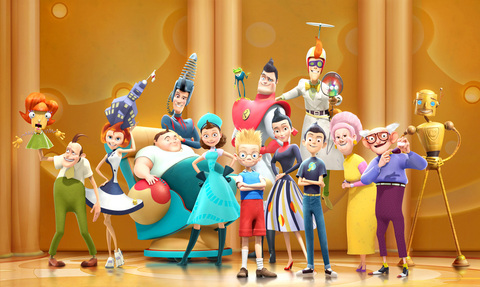There's been such an onslaught of animated movies over the past year or so, it only feels like they're coming at you in 3-D.
Meet the Robinsons actually does, and it's one of the more tolerable of the genre in recent memory.
Thankfully, it doesn't consist of smart-alecky talking animals spewing one-liners and pop culture references. And the digital three-dimensional effects are pretty spectacular. A lot of times with this technology, it's too easy to zing and fling things at the audience, simply because you can. It's gratuitous — and yes, we're talking to you, Robert Rodriguez. The most recent Spy Kids movie is a prime example of this.

PHOTO: COURTESY OF BVI/SONY
Here, the effects spring organically from the story. You feel like you're immersed in a complete universe, the way the ground slopes toward you or objects seem to come from behind you and enter the screen. As directed by Stephen Anderson, who previously worked on The Emperor's New Groove and makes his feature debut here, Meet the Robinsons has a beautifully retro art deco aesthetic — a sci-fi vision of the future as it might have been imagined during the Eisenhower administration.
The script itself, however — credited to seven people — is strictly two-dimensional. Based on the book A Day With Wilbur Robinson by William Joyce, the film follows the adventures of young Lewis (voiced by Daniel Hansen), a bespectacled boy whose mother left him at an orphanage when he was an infant. Being the science geek and aspiring inventor that he is, he creates a memory scanner in with the hope of going back and finding his mother.
(Never mind his father, who's never mentioned.)

PHOTO: COURTESY OF BVI/SONY
Instead, Lewis winds up in the future, having been whisked away by his new friend, Wilbur Robinson (Wesley Singerman). There, Wilbur's family of misfits and weirdoes offers to take him in. (Adam West and Tom Selleck are among the actors lending their voices, with Angela Bassett as the head of the orphanage. Meet the Robinsons also happens to be mercifully free of the distracting stunt casting that marks so many of these movies.)
So what's the central conflict here? Well, Lewis still wants to find his mom, of course. There's also an overly zealous, mustache-twirling guy in a bowler hat, named Bowler Hat Guy, who's after him for his device. (As voiced by director Anderson, he gets the majority of the laughs just for being such a spindly, delusional goofball.) Plus there are all those pesky time-travel issues regarding changing history, and so forth.
It's hard to feel too emotionally engaged by any of this, but its easy to watch. Kids will probably be sufficiently entertained, and adults can just sit back and enjoy the eye candy. Plus you get these cool, dark glasses that make anyone who wears them look like Roy Orbison.

May 26 to June 1 When the Qing Dynasty first took control over many parts of Taiwan in 1684, it roughly continued the Kingdom of Tungning’s administrative borders (see below), setting up one prefecture and three counties. The actual area of control covered today’s Chiayi, Tainan and Kaohsiung. The administrative center was in Taiwan Prefecture, in today’s Tainan. But as Han settlement expanded and due to rebellions and other international incidents, the administrative units became more complex. By the time Taiwan became a province of the Qing in 1887, there were three prefectures, eleven counties, three subprefectures and one directly-administered prefecture, with

It’s an enormous dome of colorful glass, something between the Sistine Chapel and a Marc Chagall fresco. And yet, it’s just a subway station. Formosa Boulevard is the heart of Kaohsiung’s mass transit system. In metro terms, it’s modest: the only transfer station in a network with just two lines. But it’s a landmark nonetheless: a civic space that serves as much more than a point of transit. On a hot Sunday, the corridors and vast halls are filled with a market selling everything from second-hand clothes to toys and house decorations. It’s just one of the many events the station hosts,

Among Thailand’s Chinese Nationalist Party (KMT) villages, a certain rivalry exists between Arunothai, the largest of these villages, and Mae Salong, which is currently the most prosperous. Historically, the rivalry stems from a split in KMT military factions in the early 1960s, which divided command and opium territories after Chiang Kai-shek (蔣介石) cut off open support in 1961 due to international pressure (see part two, “The KMT opium lords of the Golden Triangle,” on May 20). But today this rivalry manifests as a different kind of split, with Arunothai leading a pro-China faction and Mae Salong staunchly aligned to Taiwan.

Two moves show Taichung Mayor Lu Shiow-yen (盧秀燕) is gunning for Chinese Nationalist Party (KMT) party chair and the 2028 presidential election. Technically, these are not yet “officially” official, but by the rules of Taiwan politics, she is now on the dance floor. Earlier this month Lu confirmed in an interview in Japan’s Nikkei that she was considering running for KMT chair. This is not new news, but according to reports from her camp she previously was still considering the case for and against running. By choosing a respected, international news outlet, she declared it to the world. While the outside world